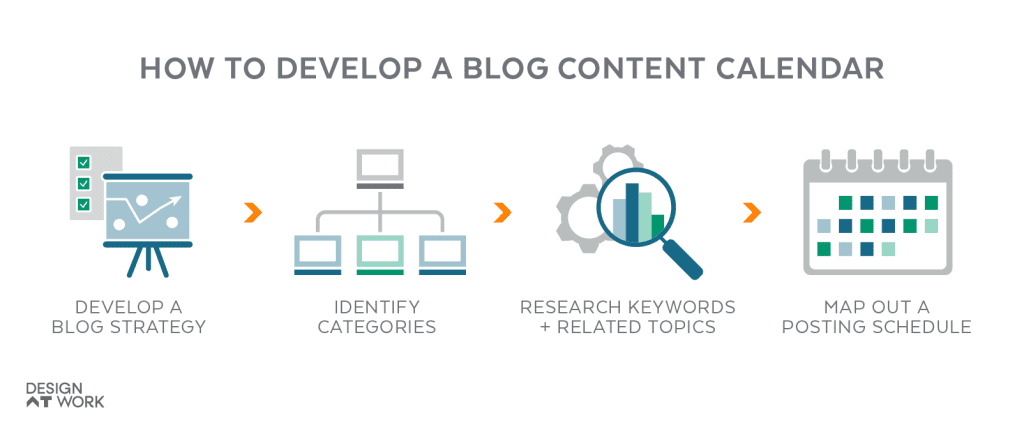Tapping into the Power of Consistent Content Marketing.

There’s an old content marketing saying: a business is only as big as its blog. Okay — we may have made that up, but the central message is still true. If you’re running a business and trying to get your company’s website to climb the digital ladder — we’re talking more visitors, increased visibility and higher search rankings — having a consistent blog post schedule can help give you a powerful boost. Let’s delve into why blogging is important, how to develop a content calendar and how sticking with it can benefit your brand.
Why Blogging is Important for
Your Business.

Publishing regular blogs — like this one — is a great way to add fresh content to your website. It also gives you the opportunity to explore specific topics related to your industry, your company or your customers’ interests in a more in-depth way. More than three quarters of online users — 77%, in fact1— say they read blogs regularly and 61% made a purchase from a company after reading a blog.2 And that’s just the start of it! Here are a few essential ways blogging at a regular cadence can help your business.
Drive Traffic to Your Website.
A great content marketing strategy can be valuable when regularly posted content drives consistent traffic to your website. With each new blog post comes a new indexed page on your website, which presents more opportunities for your site to show up on search engines. Sharing your blog posts on social media or in monthly eNewsletters will also lead more people to your website when they click to read your post. As a bonus, consistent blogs will keep your social media presence going, too.
Refresh SEO and Boost SERP Rankings.
Google loves fresh content, and consistent updates mean its bots will crawl your site more frequently, again helping to improve search rankings for your content’s targeted SEO keywords on search engine results pages (SERPs). Engaging blog content encourages readers to spend more time on your site, and the resulting low bounce rate and longer average visit times will also improve your search engine rankings.
Establish Your Business as an Authority in Your Field.
The more you post about the products and services you have expertise in, the more you’ll position your company as a leading authority in your industry. Regularly sharing high quality blogs on topics relevant to your customers’ interests — specifically, what they are searching for online —helps raise your brand awareness as a leader in the field. This can be a powerful sales tool with the potential to convert blog post readers into long-term loyal customers.

Stay Consistent with a Blog Content Calendar.

A well-defined blog strategy and content calendar give your business the framework for consistent blogging. This will help provide the timeline, topics and overall structure for the blog. While some self-employed business owners aim to blog daily, other businesses may opt for a weekly or monthly cadence. When developing your calendar, you’ll want to take into consideration the current workload, pace and overall goals to set a content creation schedule that best suits your business’ needs.
Develop a Blog Strategy.
When developing your content calendar strategy, think about what questions your customers would like answers to. How can your business educate them or share interesting insights? Readers tend to gravitate toward high-value, helpful blog content like guides and lists. In fact, 17% of all blog titles include the phrase “How to” to hook readers.3
Identify Categories.
Think of categories in terms of big picture “buckets” that your blogs can be organized into. For example, you may want to have a category for Company News that would include blogs about new product releases, new hires, training certifications or even community events.
Research Keywords and Related Topics.
There are several tools, such as Semrush and Ahrefs, built to help you conduct in-depth SEO research. During this process, consider not only broad, high-volume keywords, but also long-tail keywords — which are more specific, usually longer phrases related to larger categories. For example, let’s say you’re writing an article about running shoes. The obvious broad (or short-tail) keyword would be “running shoes,” whereas “how to pick running shoes” or “running shoes for high arches” might be among your long-tail keywords. Develop “clusters” with groups of related keywords and topics to guide your blogs.
Map Out a Posting Schedule.
Once you have those elements in place, you can start developing your calendar. Decide what cadence you want to follow — once a week, a month or a quarter are all good starting points, depending on your workload, content volume and goals.
Why Outsource Your Business’
Blog Creation?

As a business owner, your schedule and to-do list are already jam packed. The prospect of researching, writing, editing and publishing regular blogs may seem daunting, if not flat out impossible. Well, that’s where an outsourced marketing agency like Design At Work comes in. We have a team of dedicated copywriters who can conduct SEO keyword research, build out a content calendar and write fresh blogs for your business. We work closely with your team to understand your business’ mission, vision and goals — as well as your competitors and where you stand in the market. From there, our copywriters research, draft and refine content for your blogs on a consistent schedule so that your site’s content stays fresh.
You’re not alone when it comes to telling your story. Partner with a savvy marketing team that knows how to craft head-turning blog posts. Reach out to Design At Work to tell us about your goals, and our team will help put your business on the path to content marketing success.
Marketing Emails You’ll Actually Want To Read.
Get marketing tips and news sent to your inbox.


